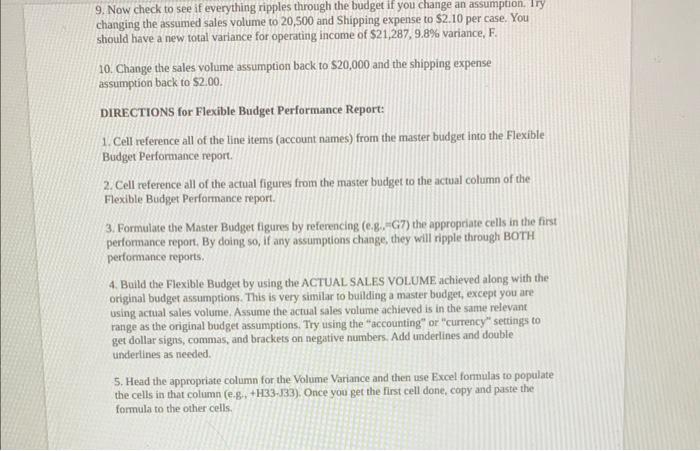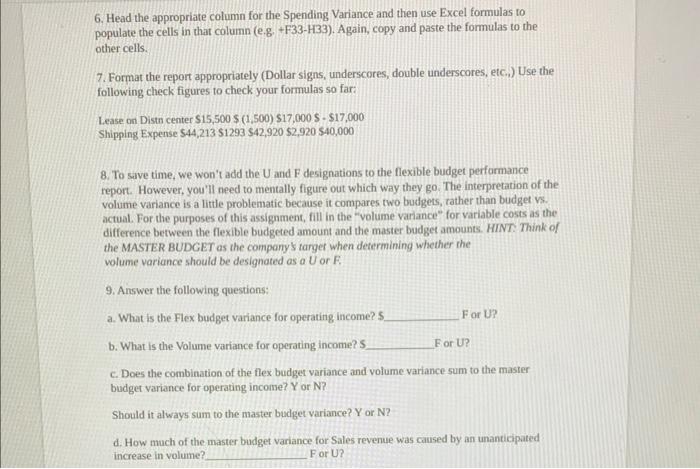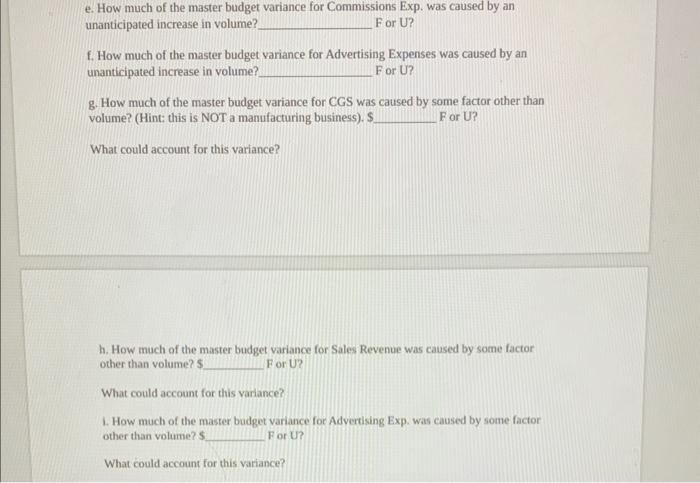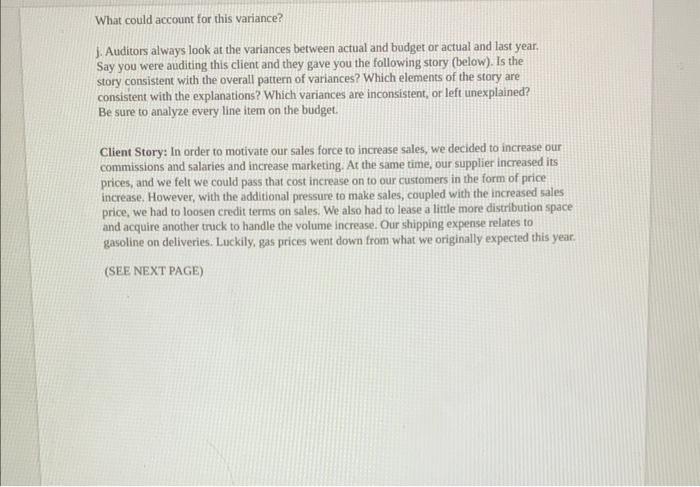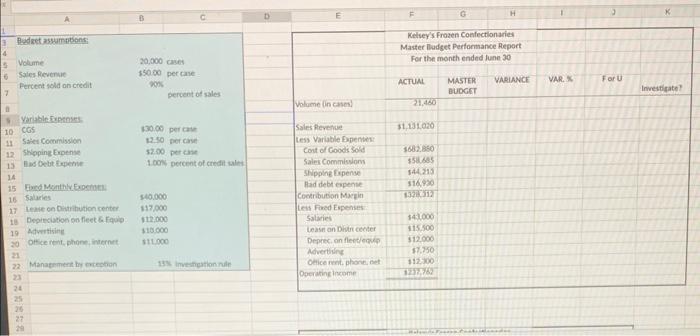Please help all required parts.

Kelsey's Frozen Confectionaries buys and distributes single-serve ice cream treats, popsicles, etc., such as those sold at convenience stores, sporting events and amusement parks. Download the file containing Kelsey's budget assumptions and actual figures for June. The file also contains a draft for both a 1) master budget performance report, and 2) a flexible budget performance report. Upload this completed packet and your Excel file to Blackboard. Use "Flex Budget Last Name" as the file name for the packet. ALSO, put your name on the FILE NAME of your Excel spreadsheet. DIRECTIONS for Master Budget Performance Report: 1. Use the budget assumptions, along with Excel formulas, to populate the Master Budget column. Note: Your formulas must work such that if ANY of the budget assumptions change, the new assumptions ripple through the entire budget. Part of your grade will be based on whether you correctly formulated the cells. Do NOT TYPE A NUMBER IN ANY CELL!!! 2. Use a formula to calculate the "variance" in cell H7: (Actual - Budget). Copy and paste the formula to the rest of the cells in the column. Leave as positive or negative, rather than absolute values. 3. Use a formula to calculate the "Variance percentage". NOTE: The percentage is the variance as a percent of the Master Budget. Copy and paste the formula to the rest of the cells in the column 4. Format cells appropriately (dollar signs using the accounting or currency format, underlines, double underlines, zero decimal places for dollar amounts, etc..). 5. Use the "If" statement function to show the variances as U or F. The "If" statement can be found under "Formulas, Logical". Example: =IF(H7>=0, "F". "U"). This formula means "If cell H7>0O or H7=0, then mark as "F". If not greater than or equal to 0 , mark as U ". Be careful with revenues and expense variances since you'll want them to be opposite of one another. Any variance of " 0 should be shown as "F" since it meets budget expectations. 6. Check your answers using the following check figures: Budgeted CM=$301,000; Budgeted Operating Income =$211,000; Variance for Commissions = $8,685; Variance percentage for Commissions =17.4%, Unfavorable. 7. Answer the following questions: a. What is the master budget yariance for Shipping exp.? $. %,U or F ? What does it mean? b. What is the master budget variance for Lease Exp? \$ \%, U or F ? What does it mean? 8. Use management by exception to determine which variances to investigate. HINT: In column K, use the "If function", along with "Absolute value function" to find the variances that are larger than the decision rule. Also, since the decision rule is in B2t and you want Excel to always compare to B21, you need to make it an absolute reference: SBS21. For oyamnle =IF(ARS(K7IS(SRS21) - yes" "no"). 9. Now check to see if everything ripples through the budget if you change an assumption, Iry changing the assumed sales volume to 20,500 and Shipping expense to $2.10 per case. You should have a new total varlance for operating income of $21,287,9.8% variance, F. 10. Change the sales volume assumption back to $20,000 and the shipping expense assumption back to $2.00. DIRECTIONS for Flexible Budget Performance Report: 1. Cell reference all of the line items (account names) from the master budget into the Flexible Budget Performance report. 2. Cell reference all of the actual figures from the master budget to the actual column of the Flexible Budget Performance report. 3. Formulate the Master Budget figures by referencing (e.g., G7) the appropriate cells in the first performance report. By doing so, if any assumptions change, they will ripple through BOTH performance reports. 4. Build the Flexible Budget by using the ACTUAL SALES VOLUME achieved along with the original budget assumptions. This is very similar to building a master budget, except you are using actual sales volume. Assume the actual sales volume achieved is in the same relevant range as the original budget assumptions. Try using the "accounting" or "currency" settings to get dollar signs, commas, and brackets on negative numbers. Add underlines and double undertines as needed. 5. Head the appropriate column for the Volume Variance and then use Excel formulas to populate the cells in that column (e.g. +H3333 ). Once you get the first cell done, copy and paste the formula to the other cells. 6. Head the appropriate column for the Spending Variance and then use Excel formulas to populate the cells in that column (e.g,+F33H33). Again, copy and paste the formulas to the other cells. 7. Format the report appropriately (Dollar signs, underscores, double underscores, etc.) Use the following check figures to check your formulas so far: Lease on Distn center $15,500$(1,500)$17,000$$17,000 Shipping Expense \$44,213 \$1293 \$42,920\$2,920\$40,000 8. To save time, we won't add the U and F designations to the flexible budget performance report. However, you'll need to mentally figure out which way they go. The interpretation of the volume variance is a little problematic because it compares two budgets, tather than budget vs. actual. For the purposes of this assignment, fill in the "volume variance" for variable costs as the difference between the flexible budgeted amount and the master budget amounts. HINT. Think of the MASTER BUDGET as the company $ target when determining whether the volume variance should be designated as a U or F. 9. Answer the following questions: e. How much of the master budget variance for Commissions Exp. was caused by an unanticipated increase in volume? F or U? f. How much of the master budget variance for Advertising Expenses was caused by an unanticipated increase in volume? F or U? g. How much of the master budget variance for CGS was caused by some factor other than volume? (Hint: this is NOT a manufacturing business).. F or U? What could account for this variance? h. How much of the master budeet variance for Sales Revenue was caused by some factor other than volume? F or U? What could account for this variance? 1. How much of the master budeet variance for Advertising Exp. was caused by some factor other than volume? $ ForU? What could account for this variance? What could account for this variance? j. Auditors always look at the variances between actual and budget or actual and last year. Say you were auditing this client and they gave you the following story (below). Is the story consistent with the overall pattern of variances? Which elements of the story are consistent with the explanations? Which variances are inconsistent, or left unexplained? Be sure to analyze every line item on the budget. Client Story: In order to motivate our sales force to increase sales, we decided to increase our: commissions and salaries and increase marketing. At the same time, our supplier increased its prices, and we felt we could pass that cost increase on to our customers in the form of price increase. However, with the additional pressure to make sales, coupled with the increased sales price, we had to loosen credit terms on sales. We also had to lease a little more distribution space and acquire another truck to handle the volume increase. Our shipping expense relates to gasoline on deliveries. Luckily, gas prices went down from what we originally expected this year. (SEE NEXT PAGE) In the table below, classify EACH ACCOUNT on the budget according to whether the variances in the performance report are consistent or inconsistent with the client's story, or unexplained by the client's story. Place an " X " in the appropriate column. If the Flexible Budget Variance and Sales Volume Variance differ with respect to one account (i.e., one is consistent and one is Kelsey's Frozen Confectionaries Fexible Budget Performance Report For the month ended June 30 ACTUAL \begin{tabular}{l|l} FLEXIBLE & MASTER \\ BUDGET & BUDGET \end{tabular} Kelsey's Frozen Confectionaries buys and distributes single-serve ice cream treats, popsicles, etc., such as those sold at convenience stores, sporting events and amusement parks. Download the file containing Kelsey's budget assumptions and actual figures for June. The file also contains a draft for both a 1) master budget performance report, and 2) a flexible budget performance report. Upload this completed packet and your Excel file to Blackboard. Use "Flex Budget Last Name" as the file name for the packet. ALSO, put your name on the FILE NAME of your Excel spreadsheet. DIRECTIONS for Master Budget Performance Report: 1. Use the budget assumptions, along with Excel formulas, to populate the Master Budget column. Note: Your formulas must work such that if ANY of the budget assumptions change, the new assumptions ripple through the entire budget. Part of your grade will be based on whether you correctly formulated the cells. Do NOT TYPE A NUMBER IN ANY CELL!!! 2. Use a formula to calculate the "variance" in cell H7: (Actual - Budget). Copy and paste the formula to the rest of the cells in the column. Leave as positive or negative, rather than absolute values. 3. Use a formula to calculate the "Variance percentage". NOTE: The percentage is the variance as a percent of the Master Budget. Copy and paste the formula to the rest of the cells in the column 4. Format cells appropriately (dollar signs using the accounting or currency format, underlines, double underlines, zero decimal places for dollar amounts, etc..). 5. Use the "If" statement function to show the variances as U or F. The "If" statement can be found under "Formulas, Logical". Example: =IF(H7>=0, "F". "U"). This formula means "If cell H7>0O or H7=0, then mark as "F". If not greater than or equal to 0 , mark as U ". Be careful with revenues and expense variances since you'll want them to be opposite of one another. Any variance of " 0 should be shown as "F" since it meets budget expectations. 6. Check your answers using the following check figures: Budgeted CM=$301,000; Budgeted Operating Income =$211,000; Variance for Commissions = $8,685; Variance percentage for Commissions =17.4%, Unfavorable. 7. Answer the following questions: a. What is the master budget yariance for Shipping exp.? $. %,U or F ? What does it mean? b. What is the master budget variance for Lease Exp? \$ \%, U or F ? What does it mean? 8. Use management by exception to determine which variances to investigate. HINT: In column K, use the "If function", along with "Absolute value function" to find the variances that are larger than the decision rule. Also, since the decision rule is in B2t and you want Excel to always compare to B21, you need to make it an absolute reference: SBS21. For oyamnle =IF(ARS(K7IS(SRS21) - yes" "no"). 9. Now check to see if everything ripples through the budget if you change an assumption, Iry changing the assumed sales volume to 20,500 and Shipping expense to $2.10 per case. You should have a new total varlance for operating income of $21,287,9.8% variance, F. 10. Change the sales volume assumption back to $20,000 and the shipping expense assumption back to $2.00. DIRECTIONS for Flexible Budget Performance Report: 1. Cell reference all of the line items (account names) from the master budget into the Flexible Budget Performance report. 2. Cell reference all of the actual figures from the master budget to the actual column of the Flexible Budget Performance report. 3. Formulate the Master Budget figures by referencing (e.g., G7) the appropriate cells in the first performance report. By doing so, if any assumptions change, they will ripple through BOTH performance reports. 4. Build the Flexible Budget by using the ACTUAL SALES VOLUME achieved along with the original budget assumptions. This is very similar to building a master budget, except you are using actual sales volume. Assume the actual sales volume achieved is in the same relevant range as the original budget assumptions. Try using the "accounting" or "currency" settings to get dollar signs, commas, and brackets on negative numbers. Add underlines and double undertines as needed. 5. Head the appropriate column for the Volume Variance and then use Excel formulas to populate the cells in that column (e.g. +H3333 ). Once you get the first cell done, copy and paste the formula to the other cells. 6. Head the appropriate column for the Spending Variance and then use Excel formulas to populate the cells in that column (e.g,+F33H33). Again, copy and paste the formulas to the other cells. 7. Format the report appropriately (Dollar signs, underscores, double underscores, etc.) Use the following check figures to check your formulas so far: Lease on Distn center $15,500$(1,500)$17,000$$17,000 Shipping Expense \$44,213 \$1293 \$42,920\$2,920\$40,000 8. To save time, we won't add the U and F designations to the flexible budget performance report. However, you'll need to mentally figure out which way they go. The interpretation of the volume variance is a little problematic because it compares two budgets, tather than budget vs. actual. For the purposes of this assignment, fill in the "volume variance" for variable costs as the difference between the flexible budgeted amount and the master budget amounts. HINT. Think of the MASTER BUDGET as the company $ target when determining whether the volume variance should be designated as a U or F. 9. Answer the following questions: e. How much of the master budget variance for Commissions Exp. was caused by an unanticipated increase in volume? F or U? f. How much of the master budget variance for Advertising Expenses was caused by an unanticipated increase in volume? F or U? g. How much of the master budget variance for CGS was caused by some factor other than volume? (Hint: this is NOT a manufacturing business).. F or U? What could account for this variance? h. How much of the master budeet variance for Sales Revenue was caused by some factor other than volume? F or U? What could account for this variance? 1. How much of the master budeet variance for Advertising Exp. was caused by some factor other than volume? $ ForU? What could account for this variance? What could account for this variance? j. Auditors always look at the variances between actual and budget or actual and last year. Say you were auditing this client and they gave you the following story (below). Is the story consistent with the overall pattern of variances? Which elements of the story are consistent with the explanations? Which variances are inconsistent, or left unexplained? Be sure to analyze every line item on the budget. Client Story: In order to motivate our sales force to increase sales, we decided to increase our: commissions and salaries and increase marketing. At the same time, our supplier increased its prices, and we felt we could pass that cost increase on to our customers in the form of price increase. However, with the additional pressure to make sales, coupled with the increased sales price, we had to loosen credit terms on sales. We also had to lease a little more distribution space and acquire another truck to handle the volume increase. Our shipping expense relates to gasoline on deliveries. Luckily, gas prices went down from what we originally expected this year. (SEE NEXT PAGE) In the table below, classify EACH ACCOUNT on the budget according to whether the variances in the performance report are consistent or inconsistent with the client's story, or unexplained by the client's story. Place an " X " in the appropriate column. If the Flexible Budget Variance and Sales Volume Variance differ with respect to one account (i.e., one is consistent and one is Kelsey's Frozen Confectionaries Fexible Budget Performance Report For the month ended June 30 ACTUAL \begin{tabular}{l|l} FLEXIBLE & MASTER \\ BUDGET & BUDGET \end{tabular}



